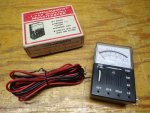mikethedruid
Member

This is my Knight Kit Star Roamer. It is not my first Star Roamer. My first I built from a kit my parents got me for Christmas when I was 14 years old in the mid 1960s. I foolishly lent it to an English friend of mine so he could listen to the BBC during the Falklands War and never got it back. This is the second one I built from a kit I bought from Radio Shack when they were closing them out, and saved un-built for many years.
The Star Roamer is a glorified "All American Five" employing 4 tubes and a solid state rectifier. It uses a power supply transformer, so the chassis is isolated from ground. As a kit radio, performance depends largely on the care and skill used in its construction; but, when well built, it is a decent performer, certainly on par with, or slightly better than, the National NC-60 Special. It is continuous coverage between 540 KC and 30 MC, as well as long wave from 200 to 400 KC in 5 bands: 200 - 400 KC, 540 - 1800 KC, 1.8 - 4.8 MC, 4.8 - 12 MC, and 12 - 30 MC. Bandspread is electrical with a separate condenser calibrated 0 - 100, and not to specific frequencies.It can receive CW and SSB using over driven feedback in the IF sensitivity circuit to act as a BFO. In its day, it was very popular being about the best performance you could get for the price. Many of today's older shortwave listeners got their start with this radio. The manual, including the schematic, can be found here: Knight Kit Star Roamer Manual .


